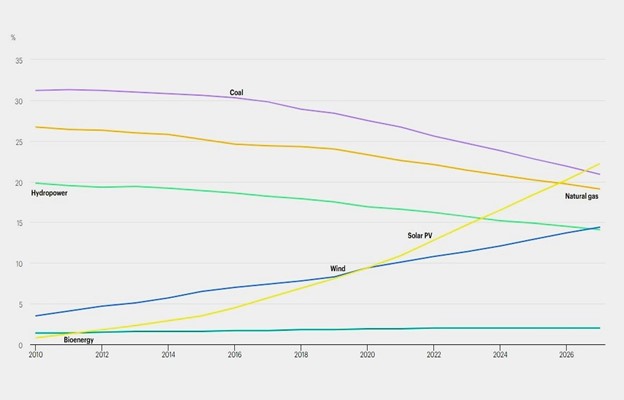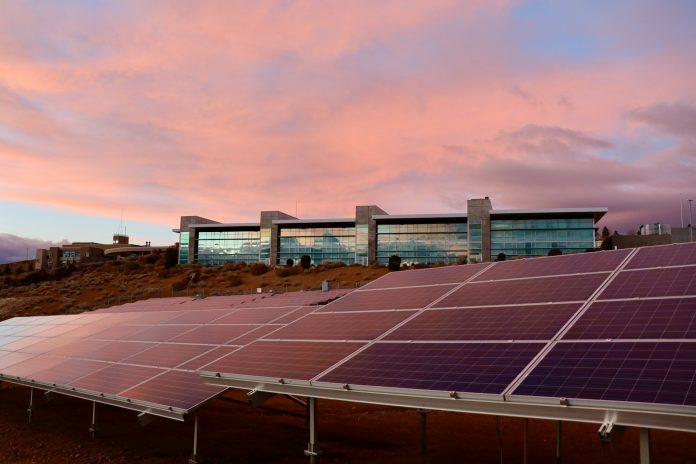The Sun is the main source of energy on our planet. Every second a huge amount of heat from the Sun reaches the Earth, 10000 times more than all the energy consumed in the world.
Given the growing awareness of economic, environmental, and other problems associated with the use of traditional energy resources, interest in solar systems is increasing every day.
Projections of the role of electricity during this new century show an increase in current consumption by at least a factor of two and a half, and possibly a factor of five. All scenarios point to continued use of fossil, nuclear, and large hydroelectric power. However, the largest increase is in “new sources of renewable energy,” and all scenarios show widespread use of these sources by 2050. Indeed, projections show that the amount of energy from new renewables by 2050 will exceed the amount of energy currently derived from oil and gas combined. This would mean the world’s largest energy infrastructure and a huge development of solar companies.
Prospects for the Development of Solar Power Industry
Since 1967, solar energy satellites have been attempting to collect solar energy in space and transmit it to Earth. With the energy crisis of the early 1970s, it was seriously considered as an alternative to producing electricity from fossil fuels. With increasing global electricity demand, and growing concerns about urban smog and the greenhouse effect, harvesting solar energy from space is again attracting major interest.
Solar radiation can be collected more efficiently in space, where it is about three times stronger than on the Earth’s surface and can be collected 24 hours a day (since there are no clouds or night in high Earth orbit). Solar energy from space can be transported to areas with the highest demand at any given time.
Most of these systems will use photovoltaic cells similar to those used in systems on Earth (e.g., home solar panels and road sign panels). Others will use reflectors and mechanical collectors similar to those used in dedicated large-scale solar installations in France and the California desert (Barstow). Some PV technologies also use reflective concentrators.
Most of these systems collect solar energy in space and transmit it via a beam of microwave energy to an Earth antenna, which converts the beam into electricity for use on Earth.
Microwave beams have fairly low wavelengths (lower than visible light) and do not appear to pose any danger to Earth’s atmosphere. Telephone companies have been beaming microwaves through the atmosphere for more than thirty years without any known problems.
High start-up costs are the biggest obstacle to the development of solar power transmission from space. However, the growing electricity demand may exceed traditional production capabilities, raising prices to a level where solar power from space is competitive. If restrictions are placed on electricity generation by burning coal (to reduce pollution), solar power from space could become competitive even sooner.
Four key steps in the solar industry outlook:
- Capturing solar energy in space and converting it into electricity.
- Converting it into radio frequency and transmitting it to Earth.
- Receiving radio frequency waves on Earth and converting them into electricity.
- Providing electricity to utility networks with the help of promising solar energy.
Solar Panel Installations
Historically, solar panels are the second attempt of mankind to curb the boundless energy of the Sun and make it work for their benefit. The first to appear were solar collectors (solar thermal power plants), in which electricity is generated by water heated to boiling point under concentrated sunlight.
More and more countries are paying attention to the mass use of solar panels in households and utilities. The “technologically advanced” regions include not only the solar resorts of Spain, Italy, or, say, the west coast of the USA, but also, for example, Germany, Sweden or Finland. By 2027, installed solar power capacity will exceed coal power and become the largest in the world.

The Main Advantages of Solar Panels
- High reliability: The construction of solar panels has no mechanical, or moving parts, so it has a high margin of reliability, which is confirmed by its use in places where repair is practically impossible – space systems, etc.
- Minimal operating costs: After installation, solar panels do not require much attention, routine maintenance, and service. This allows the panels to be used in hard-to-reach places where maintenance is either expensive or cannot be carried out.
- Environmental friendliness: There are no harmful emissions or waste when solar panels are in operation. Solar panels operate silently.
- Lifespan: To date, the service life of solar panels is brought to 20-25 years.
- Ease of installation: Installation of the system is quite simple. Changing the output power is achieved by simply adding or removing modules. In other words, it is possible to gradually increase the power output as needed and financially feasible.
For well-known reasons, interest in solar panels is growing every year, hence the effort of manufacturers to provide the market. As analysts point out, today’s production volumes do not meet the needs, and although production capacity is increasing every year, the cost of a solar panel is not yet economically interesting in all countries. Manufacturers are striving to optimize the cost of solar panel production costs, and the increasing demand contributes to the “convergence” of the production and purchase processes.
Where to Install the Solar Panels
Solar panels can be placed in almost any well-lit location:
- On the roof of a country cottage.
- On the balcony of an apartment building.
- On the territory adjacent to the house.
The main thing is to provide the necessary conditions to maximize electricity generation. One of them is the orientation and angle of inclination relative to the horizon. So the light-absorbing surface of the unit should be directed towards the south.
Ideally, the sun’s rays should fall on it at 90°. To achieve this effect, the optimum angle of inclination must be selected depending on the climatic conditions of the region. This is different for each region.
The installation of photovoltaic systems in the facade is mainly used in multi-story office or apartment buildings. A distinction is made between cold and warm facades. If the facade is cold, the solar modules are installed directly in front of the facade and serve not only as a producer of electrical energy but also as a heat insulator, protecting the building from wind and serving as a decorative element of the architectural composition of the building. In the case of a warm facade, the solar system serves as a kind of cover for the building. Various manufacturers are producing light-permeable photovoltaic panels, as well as panels with soundproofing properties. However, such products have not yet become widespread due to their high cost.
Recently, an interesting new product from a German photomodule manufacturer has gone on sale – a solar panel that can be easily transformed into a multifunctional table. The main feature of the novelty is its ability to convert sunlight into electricity, which makes the table a suitable solution for garden areas, cafes, or open office spaces. Built-in USB ports allow you to charge your mobile devices right outside, providing simplicity and convenience.
To Sum Up, there is no doubt that the installation of solar panels is one of the most popular renewable energy 2023 trends, and the development of green energy is set to increase dramatically in the coming decades. Furthermore, it seems certain that there will be a bigger shift to renewable energy sources and that the prospects for solar energy are enormous.

Cameron Dickerson is a seasoned journalist with nearly 10 years experience. While studying journalism at the University of Missouri, Cameron found a passion for finding engaging stories. As a contributor to Kev’s Best, Cameron mostly covers state and national developments.

